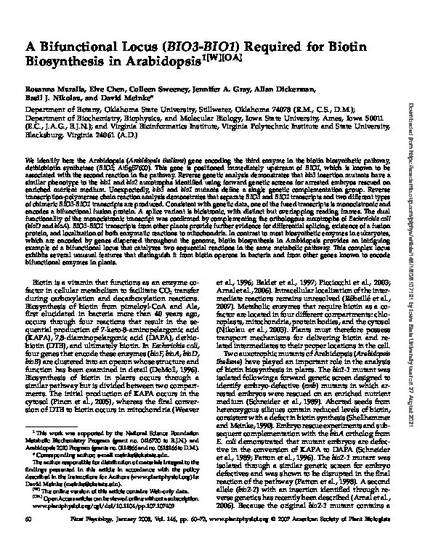
We identify here the Arabidopsis (Arabidopsis thaliana) gene encoding the third enzyme in the biotin biosynthetic pathway, dethiobiotin synthetase (BIO3; At5g57600). This gene is positioned immediately upstream of BIO1, which is known to be associated with the second reaction in the pathway. Reverse genetic analysis demonstrates that bio3 insertion mutants have a similar phenotype to the bio1 and bio2 auxotrophs identified using forward genetic screens for arrested embryos rescued on enriched nutrient medium. Unexpectedly, bio3 and bio1 mutants define a single genetic complementation group. Reverse transcription-polymerase chain reaction analysis demonstrates that separate BIO3 and BIO1 transcripts and two different types of chimeric BIO3-BIO1 transcripts are produced. Consistent with genetic data, one of the fused transcripts is monocistronic and encodes a bifunctional fusion protein. A splice variant is bicistronic, with distinct but overlapping reading frames. The dual functionality of the monocistronic transcript was confirmed by complementing the orthologous auxotrophs of Escherichia coli (bioD and bioA). BIO3-BIO1 transcripts from other plants provide further evidence for differential splicing, existence of a fusion protein, and localization of both enzymatic reactions to mitochondria. In contrast to most biosynthetic enzymes in eukaryotes, which are encoded by genes dispersed throughout the genome, biotin biosynthesis in Arabidopsis provides an intriguing example of a bifunctional locus that catalyzes two sequential reactions in the same metabolic pathway. This complex locus exhibits several unusual features that distinguish it from biotin operons in bacteria and from other genes known to encode bifunctional enzymes in plants.
Available at: http://works.bepress.com/basil-nikolau/66/

This article is published as Muralla, Rosanna, Elve Chen, Colleen Sweeney, Jennifer A. Gray, Allan Dickerman, Basil J. Nikolau, and David Meinke. "A bifunctional locus (BIO3-BIO1) required for biotin biosynthesis in Arabidopsis." Plant physiology 146, no. 1 (2008): 60-73. doi:10.1104/pp.107.107409.